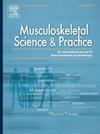心理因素和睡眠质量与肩周炎患者活动相关疼痛和残疾的关系
IF 2.2
3区 医学
Q1 REHABILITATION
引用次数: 0
摘要
肩周炎(FS)是引起高度疼痛和残疾的常见疾病。焦虑、抑郁、疼痛自我效能、运动恐惧症、疼痛灾难化和睡眠质量等心理因素可能与FS患者的活动相关疼痛和残疾有关。目的分析FS患者活动相关疼痛和残疾与心理因素和睡眠质量的关系。方法对96例FS患者进行横断面研究。心理变量包括焦虑和抑郁(医院焦虑抑郁量表)、疼痛自我效能(疼痛自我效能问卷)、运动恐惧症(坦帕运动恐惧症量表-11)、疼痛灾难化(疼痛灾难化量表)和睡眠质量(匹兹堡睡眠质量指数)。使用肩痛和残疾指数(SPADI)评估与活动相关的疼痛和残疾。控制变量包括性别、年龄、症状持续时间、FS类型、体重指数(BMI)和合并症的存在。进行单变量和多元线性回归分析。结果西班牙自我效能、运动恐惧症和BMI解释了22.3%的残疾变异(f (3.92) = 10.08, p <;0.001,校正R2 = 0.223)。疼痛自我效能和焦虑解释了21.2%的活动相关疼痛差异(f (2.93) = 13.74, p <;0.001,校正R2 = 0.212)。抑郁、疼痛灾难、睡眠质量以及其他控制变量与活动相关的疼痛和残疾没有显著相关。结论较高的自我效能评分与较低的活动相关疼痛和残疾评分相关,而较高的运动恐惧症、焦虑和BMI评分与较差的活动相关疼痛和残疾评分相关。本文章由计算机程序翻译,如有差异,请以英文原文为准。
Association of psychological factors and sleep quality with activity-related pain and disability in individuals with frozen shoulder
Background
Frozen shoulder (FS) is a common condition that cause high levels of pain and disability. Psychological factors such as anxiety, depression, pain self-efficacy, kinesiophobia, pain catastrophizing and sleep quality may be associated with activity related pain and disability in individuals with FS.
Objective
To analyze the association of psychological factors and sleep quality with activity related activity-related pain and disability in individuals with FS.
Methods
This cross-sectional study included 96 individuals with FS. Psychological variables included anxiety and depression (Hospital Anxiety and Depression Scale), pain self-efficacy (Pain Self-Efficacy Questionnaire), kinesiophobia (Tampa Scale for Kinesiophobia-11), pain catastrophizing (Pain Catastrophizing Scale), and sleep quality (Pittsburgh Sleep Quality Index). Activity-related pain and disability were assessed using the Shoulder Pain and Disability Index (SPADI). Control variables included sex, age, duration of symptoms, type of FS, body mass index (BMI), and presence of comorbidities. Univariate and multiple linear regression analyses were performed.
Results
Pain self-efficacy, kinesiophobia, and BMI explained 22.3 % of the variance in disability (f (3.92) = 10.08, p < 0.001, adjusted R2 = 0.223). Pain self-efficacy and anxiety explained 21.2 % of the variance in activity-related pain (f (2.93) = 13.74, p < 0.001, adjusted R2 = 0.212). Depression, pain catastrophizing, and sleep quality, as well as other control variables, were not significantly associated with the activity-related pain and disability.
Conclusion
Higher self-efficacy scores were associated with lower activity-related pain and disability scores, while higher kinesiophobia, anxiety, and BMI scores were associated with worse activity-related pain and disability scores.
求助全文
通过发布文献求助,成功后即可免费获取论文全文。
去求助
来源期刊

Musculoskeletal Science and Practice
Health Professions-Physical Therapy, Sports Therapy and Rehabilitation
CiteScore
4.10
自引率
8.70%
发文量
152
审稿时长
48 days
期刊介绍:
Musculoskeletal Science & Practice, international journal of musculoskeletal physiotherapy, is a peer-reviewed international journal (previously Manual Therapy), publishing high quality original research, review and Masterclass articles that contribute to improving the clinical understanding of appropriate care processes for musculoskeletal disorders. The journal publishes articles that influence or add to the body of evidence on diagnostic and therapeutic processes, patient centered care, guidelines for musculoskeletal therapeutics and theoretical models that support developments in assessment, diagnosis, clinical reasoning and interventions.
 求助内容:
求助内容: 应助结果提醒方式:
应助结果提醒方式:


